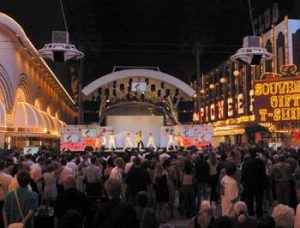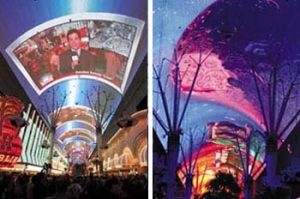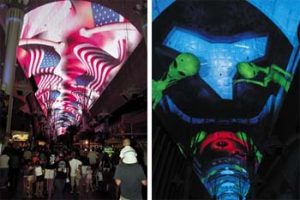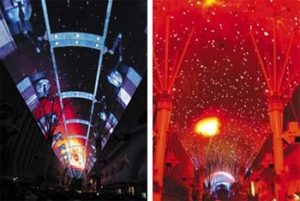Electric Signs
Night Lights
More colorful and brilliant, the Fremont Street Experience upgrades to an LED screen.
Published
18 years agoon
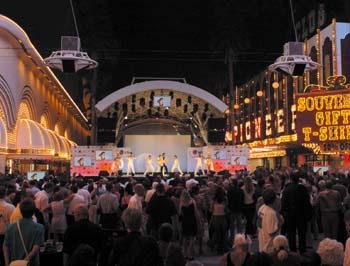
The energy, excitement and glitter of Las Vegas isn’t only on the Strip. That’s the message the team behind the Fremont Street Experience (FSE) seeks to convey with the $17 million overhaul and light-emitting diode (LED) upgrade to its four-block-long electronic canopy in downtown Vegas.
In 1995, FSE formed as a public/private partnership — which included the city and a group of 10 downtown casino/hotels –to lead the charge to construct a massive, groundbreaking, $70 million, graphic-display system on the underside of a canopy 90 ft. above a pedestrian-only stretch of Fremont Street downtown (see ST, January 1996, page 132).
A half dozen times each night, at the top of the hour, neighboring casinos shut off their trademark signs and marquees, and visitors move their eyes skyward for a 10-minute animated light show choreographed to music.
In 1997, 70% of Las Vegas visitors ventured downtown. By 2003, that number had fallen to 46%, according to the Las Vegas Convention and Visitors Authority. Faced with sagging attendance downtown, FSE officials and LG CNS Co. (Seoul, Korea) — which served as systems integrator and designer for the new screen — committed to upgrade the 1995 system with the latest LED technology. Nearly two years after conceiving the idea, the digital LED screen — dubbed "Viva Vision" — debuted with a more than 800% resolution enhancement and 16.7 million color combinations versus the original system’s 65,000 colors.
The project, funded by FSE, the convention and visitors authority, and a corporate sponsorship through LG Electronics (Seoul, Korea), is touted by its creators as the world’s "biggest big screen" — 125 ft. wide and 1,400 ft. long.
Behemoth installation
Switching from an analog incandescent "wedge" system to a digital LED system, on a screen longer than five football fields, required approximately two years — including research and development — before the new screen was unveiled in June.
Las Vegas-based Casino Lighting & Sign (CLS) handled the arduous installation. Each 22-hour workday, from September 2003 until May 2004, 28 workers — 14 workers per 11-hour shift — used six lifts to slowly traverse the canopy, both above and below the screen. They removed the old technology and two million incandescent lamps, added 32 fuses for each of the 690 transformers to bring them up to code, rewired the system and installed the new LED system, which included 12.5 million red, green and blue Toyoda Gosei (Aichi, Japan) LED lamps, said Mark Johnson, CLS president.
LG CNS subcontractor Newton Technologies (Gwangju, Korea) supplied the LED modules and control systems used to retrofit the existing canopy.
Transformers and the screen’s frame structure are among the few original components that remain from 1995, said Danny Murphy, FSE show operations and production manager.
The linear system concaves on a radius, which required installers to meticulously line up each section so each pixel was in perfect alignment with its neighbors, Johnson said. With the aid of a laser guide, they aligned 1,400 linear ft. within 4 in. of absolute accuracy — a feat Johnson called "phenomenal."
All of CLS’ equipment was removed every weekend, so as not to disrupt Fremont Street concerts and events, and replaced on Monday. During the lengthy installation process, the nightly shows continued to run, which created a challenge for the installers and production team.
"We are a 365-day operation. Our shows never go dark," Murphy said.
To keep the show operating during installation, one of eight screen sections was turned off at a time, allowing the rest of the screen to function. Once installers replaced an entire section and moved on to the next, they turned it on, and technicians electronically adjusted the pixels of the new, more brilliant LED section to match the rest of the incandescent screen, Johnson explained.
A team from LG CNS and Newton Technologies will remain in Las Vegas to provide a year of maintenance and technical support.
Making the transition
The old incandescent system comprised 30 control computers attached to the back of the screen in AC boxes, Murphy said. The new system runs on eight control computers — each of which runs one section of the screen — located inside the master control room. To the audience, the screen appears as one fluid image.
Troubleshooting a glitch in the original system often involved a radio call from a maintenance operator observing the show from the ground and a technician climbing up onto the canopy, which required up to 20 minutes, he said. The updated technology allows for troubleshooting from the control room, where technicians watch the show live on monitors.
The light and sound spectacular runs on a master show controller and three sub-systems. The controller runs Stage Manager 3000 software on an Amiga computer originally installed when the show began in 1995. Murphy said the master controller sends commands to the video-display controller, light console and digitally automated audio system. The audio system, a recently upgraded LCS Matrix 3 system, distributes 550,000W of sound through 220 remote amplifiers located throughout the outdoor mall.
The new system offers additional capabilities, Murphy said. It can show multiple feeds from any source. If needed, they could even pop in a DVD and go live without any additional programming. Live camera feeds can display real-time action taking place on the streets below. Additional capabilities include split-screen viewing, screen rotations and the integration of customized event footage.
Each LED offers an estimated 50,000-hour life, compared to the incandescent lamps’ approximately 5,000 hours. In addition to reduced maintenance costs, Murphy said the screen should offer up to a 72% power savings. The original system required four or five people to work every night. Now the shows can operate with just one or two, he said.
The screen is further enhanced by the LEDs’ proximity. The two million incandescent bulbs were 6 in. apart; the 12.5 million LED lamps are 2 in. apart, which results in sharper and more life-like images.
| A Comparison: Previous System vs. New System | |
| Incandescent Graphic Display (1995) | Digital Video Display (2004) |
| 1.9 million incandescent bulbs
477,664 pixels 65,536 colors 360GB of storage 7.8 million watts at full power Advertisement5,000-hour estimated lamp life 2,596 x 184 resolution 32 levels of luminosity 6.2-in. pixel pitch |
12.5 million LED lamps
4.1 million pixels 16.7 million colors Advertisement9,600GB of storage 2.2 million watts maximum 1.1 million watts minimum 50,000-hour estimated lamp life 7,552 x 552 resolution 256 levels of luminosity Advertisement2-in. pixel pitch |
Project Players
* LG Electronics (Seoul, Korea) Marketing partner and primary corporate sponsor of Viva Vision
* LG CNS Co. (Seoul, Korea) Contracted with FSE for technical design and development of digital video system
* Newton Technologies (Gwangju, Korea) LG CNS subcontractor on component production; also provides onsite parts and labor support in Las Vegas.
* Fremont Street Experience (Las Vegas) A public-private partnership formed in 1995 between the city of Las Vegas and the Fremont Street Experience LLC, owned by a group of 10 downtown casino/hotels that underwrite operating expenses for the venue
* Casino Lighting & Sign (Las Vegas) Directed the installation of the technology upgrade within the canopy
* The Export-Import Bank of Korea (Seoul, Korea) Financial liaison for Viva Vision canopy
* Digital Display Consultants Display consultant Rex D. Williams served as chief negotiator for LG CNS Co.; he worked with FSE to fabricate and install the display system. He also spearheaded the negotiations for the LG Electronics sponsorship with FSE.

SPONSORED VIDEO
Introducing the Sign Industry Podcast
The Sign Industry Podcast is a platform for every sign person out there — from the old-timers who bent neon and hand-lettered boats to those venturing into new technologies — we want to get their stories out for everyone to hear. Come join us and listen to stories, learn tricks or techniques, and get insights of what’s to come. We are the world’s second oldest profession. The folks who started the world’s oldest profession needed a sign.
You may like

4 of the Most Fun Sign Projects in Years

Sign Pro’s Phrase Coaches Customers with Bad Ideas

2024 Sign Contest Open for Submission
Subscribe

Bulletins
Get the most important news and business ideas from Signs of the Times magazine's news bulletin.
Most Popular
-

 Paula Fargo2 weeks ago
Paula Fargo2 weeks ago5 Reasons to Sell a Sign Company Plus 6 Options
-

 Real Deal1 week ago
Real Deal1 week agoA Woman Sign Company Owner Confronts a Sexist Wholesaler
-

 Photo Gallery2 weeks ago
Photo Gallery2 weeks ago21 Larry Albright Plasma Globes, Crackle Tubes and More
-

 Projects1 week ago
Projects1 week agoGraphics Turn an Eyesore Cooler Into a Showpiece Promo in Historic Plaza
-

 Business Management1 week ago
Business Management1 week ago3 Things Print Pros Must Do to Build Stronger Relationships in the Interiors Market
-

 News1 day ago
News1 day ago2024 Sign Contest Open for Submission
-

 Projects21 hours ago
Projects21 hours ago4 of the Most Fun Sign Projects in Years
-

 News1 week ago
News1 week agoPattison ID New Name of Five Companies
